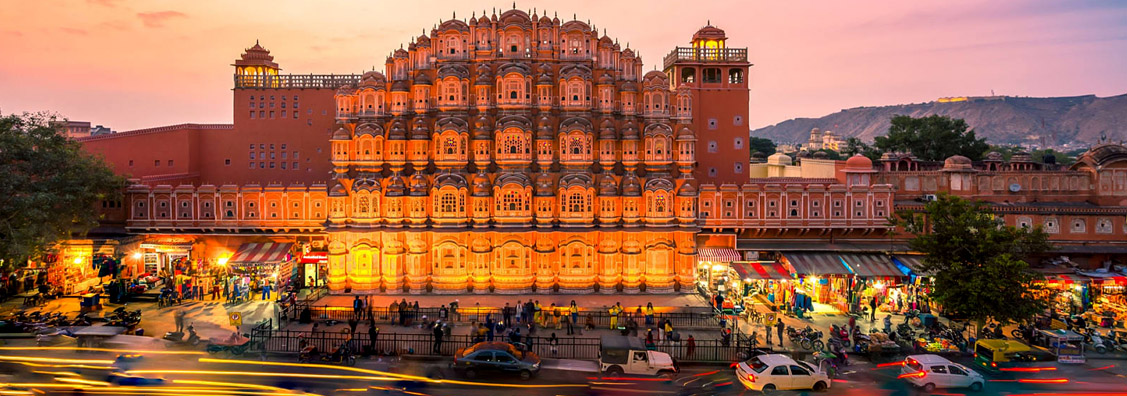

Home / Attractions / Jaipur
Jaipur the capital of Rajasthan state in India was founded in 1727 by Maharaj Jai Singh II, It is every traveller's delight. It has plenty to offer in terms of culture, activities and sightseeing. A key part of Rajput history, Rajasthan's capital city will spoil you for choice, particularly if you enjoy a bit of the old world. Jaipur is a very peaceful city and moderate city, It's population is counted 3.1 million in year 2018.
There are some stunning forts and palaces to see in Jaipur, and then there is shopping. In Jaipur you can explore the many markets and get yourself amazing local Rajasthani products to take back home. Have a look at what makes Jaipur a top choice for travellers in this informative guide to what Jaipur is famous for Jewels Work, Gem Stone Textiles, Carpets, Painting, Sarees and Handicrafts Work.
Maharaja Jai Singh II was a Kachhwaha Rajput ruled Jaipur State from 1699–1744,. Initially his capital was Amber, which lies at a distance of 11 km from Jaipur. He felt the need of shifting his capital city with the increase in population and growing scarcity of water. Jaipur is the first planned city of India and the King took great interest while designing this city of victory. He consulted several books on architecture and architects before making the layout of Jaipur.
With a strategic plan, the construction of the city started in 1727. It took around 4 years to complete the major palaces, roads and square. The city was built following the principles of Vastu Shastra.
According to that time, architecture of the town was very advanced and certainly the best in Indian subcontinent. In 1876, when Prince of Wales visited Jaipur, the whole city was painted pink to welcome him and after that Jaipur was titled 'Pink City'. Still, the neat and broadly laid-out avenues, painted in pink provide a magical charm to the city. Jaipur is rich in its cultural and architectural beauty, which can be traced in the various historical and aesthetic places that reside in the city.
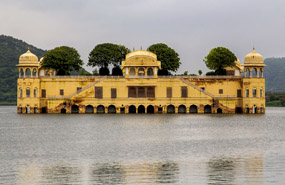
Jal Mahal (meaning "Water Palace") is a palace in the middle of the Man Sagar Lake in Jaipur city, the capital of the state of Rajasthan, India. The palace and the lake around it were renovated and enlarged in the 18th century by Maharaja Jai Singh II of Amber.
The Mahal is a testament to the bond that was formed between the Rajput's and Mughal Empire. The architecture of the palace has resemblance of both types of construction.
The beauty of the palace was the enhanced by many generations of Maharajas. For example Maharaja Jai Singh II added to the beauty of the palace by creating gardens to make the Jal Mahal more picturesque. After generations of creativity we today have the magnificence of the "water palace".
The Jal Mahal palace is an architectural showcase of the Rajput style of architecture (common in Rajasthan) on a grand scale. The building has a picturesque view of the lake itself but owing to its seclusion from land is equally the focus of a viewpoint from the Man Sagar Dam on the eastern side of the lake in front of the backdrop of the surrounding Nahargarh ("tiger-abode") hills. The palace, built in red sandstone, is a five storied building, of which four floors remain underwater when the lake is full and the top floor is exposed.[1]One rectangular Chhatri on the roof is of the Bengal type. The chhatris on the four corners are octagonal. The palace had suffered subsidence in the past and also partial seepage (plasterwork and wall damage equivalent to rising damp) because of waterlogging, which have been repaired under a restoration project of the Government of Rajasthan. The hills surrounding the lake area, towards the north east of Jaipur, have quartzite rock formations (with a thin layer of soil cover), which is part of Aravalli hills range. Rock exposures on the surface in some parts of the project area have also been used for constructing buildings. From the north east, the Kanak Vrindavan valley, where a temple complex sits, the hills slope gently towards the lake edge. Within the lake area, the ground area is made up of a thick mantle of soil, blown sand and alluvium. Forest denudation, particularly in the hilly areas, has caused soil erosion, compounded by wind and water action. As a result, silt built up in the lake incrementally raises the lake bed.[3] On the terrace of the palace, a garden was built with arched passages. At each corner of this palace semi-octagonal towers were built with an elegant cupola.[4] The restoration works of the early 2000s were not satisfactory and an expert in the field of similar architectural restoration works of Rajasthan palaces carefully examined the designs that could decipher the originally existing designs on the walls, after removing the recent plaster work. Based on this finding, restoration works were re-done with traditional materials for plastering – the plaster consists of a partly organic material: a mortar mix of lime, sand and surkhi mixed with jaggery, guggal and methi powder. It was also noticed that there was hardly any water seepage, except for a little dampness, in the floors below the water level. But the original garden, which existed on the terrace had been lost. Now, a new terrace is being created based on a similar roof garden of the Amer palace.[1] The building is located near the shoreline of a lake with a maximum depth of 15 ft. Though 4 stories of the building are under the surface of the water, they would be build into the bed of the lake.
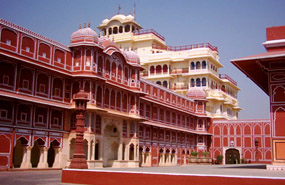
City Palace, Jaipur, which includes the Chandra Mahal and Mubarak Mahal palaces and other buildings, is a palace complex in Jaipur, the capital of the Rajasthan state, India. It was the seat of the Maharaja of Jaipur, the head of the Kachwaha Rajput clan. The Chandra Mahal palace now houses a museum, but the greatest part of it is still a royal residence. The palace complex, located northeast of the centre of the grid-patterned Jaipur city, incorporates an impressive and vast array of courtyards, gardens and buildings. The palace was built between 1729 and 1732, initially by Sawai Jai Singh II, the ruler of Amber. He planned and built the outer walls, and later additions were made by successive rulers continuing up to the 20th century. The credit for the urban layout of the city and its structures is attributed to two architects namely, Vidyadhar Bhattacharya, the chief architect in the royal court and Sir Samuel Swinton Jacob, apart from the Sawai himself who was a keen architectural enthusiast. The architects achieved a fusion of the Shilpa Shastra of Indian architecture with Rajput, and Mughal.
The palace complex lies in the heart of Jaipur city, to the northeast of the very centre, located at 26.9255°N 75.8236°E. The site for the palace was located on the site of a royal hunting lodge on a plain land encircled by a rocky hill range, five miles south of Amber (city). The history of the city palace is closely linked with the history of Jaipur city and its rulers, starting with Maharaja Sawai Jai Singh II who ruled from 1699 to 1744. He is credited with initiating construction of the city complex by building the outer wall of the complex spreading over many acres. Initially, he ruled from his capital at Amber, which lies at a distance of 11 kilometres (6.8 mi) from Jaipur. He shifted his capital from Amber to Jaipur in 1727 because of an increase in population and increasing water shortage. He planned Jaipur city in six blocks separated by broad avenues, on the classical basis of principals of Vastushastra and other similar classical treatise under the architectural guidance of Vidyadar Bhattacharya, a Bengali architect from Naihati of present-day West Bengal who was initially an accounts-clerk in the Amber treasury and later promoted to the office of Chief Architect by the King.
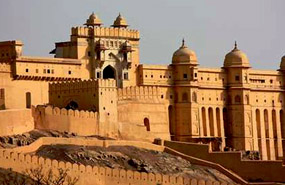
Amer Fort is a fort located in Amer, Rajasthan, India. Amer is a town with an area of 20194 square kilometres (1.5 sq mi) located 11 kilometres (6.8 mi) from Jaipur, the capital of Rajasthan. Located high on a hill, it is the principal tourist attraction in Jaipur. The town of Amer was originally built by Meenas, and later it was ruled by Raja Man Singh I. Amer Fort is known for its artistic style elements. With its large ramparts and series of gates and cobbled paths, the fort overlooks Maota Lake, which is the main source of water for the Amer Palace.
Constructed of red sandstone and marble, the attractive, opulent palace is laid out on four levels, each with a courtyard. It consists of the Diwan-i-Aam, or "Hall of Public Audience", the Diwan-i-Khas, or "Hall of Private Audience", the Sheesh Mahal (mirror palace), or Jai Mandir, and the Sukh Niwas where a cool climate is artificially created by winds that blow over a water cascade within the palace. Hence, the Amer Fort is also popularly known as the Amer Palace. The palace was the residence of the Rajput Maharajas and their families. At the entrance to the palace near the fort's Ganesh Gate, there is a temple dedicated to Shila Devi, a goddess of the Chaitanya cult, which was given to Raja Man Singh when he defeated the Raja of Jessore, Bengal in 1604. (Jessore is now in Bangladesh).
This palace, along with Jaigarh Fort, is located immediately above on the Cheel ka Teela (Hill of Eagles) of the same Aravallirange of hills. The palace and Jaigarh Fort are considered one complex, as the two are connected by a subterranean passage. This passage was meant as an escape route in times of war to enable the royal family members and others in the Amer Fort to shift to the more redoubtable Jaigarh Fort. Annual tourist visitation to the Amer Palace was reported by the Superintendent of the Department of Archaeology and Museums as 5000 visitors a day, with 1.4 million visitors during 2007.] At the 37th session of the World Heritage Committee held in Phnom Penh, Cambodia, in 2013, Amer Fort, along with five other forts of Rajasthan, was declared a UNESCO World Heritage Site as part of the group Hill Forts of Rajasthan.
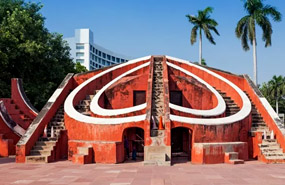
The Jantar Mantar monument in Jaipur, Rajasthan is a collection of nineteen architectural astronomical instruments built by the Rajput king Sawai Jai Singh II, and completed in 1734. It features the world's largest stone sundial, and is a UNESCO World Heritage site. It is located near City Palace and Hawa Mahal. The instruments allow the observation of astronomical positions with the naked eye. The monument expresses architectural innovations, as well as the coming together of ideas from different religious and social beliefs in 18th-century India. The observatory is an example of the Ptolemaic positional astronomy which was shared by many civilizations.
The monument features instruments operating in each of the three main classical celestial coordinate systems: the horizon-zenith local system, the equatorial system and the ecliptic system. The Kapala Yantraprakara is one that works in two systems and allows transformation of the coordinates directly from one system to the other.
The monument was damaged in the 19th century. Early restoration work was undertaken under the supervision of Major Arthur Garrett, a keen amateur astronomer, during his appointment as Assistant State Engineer for the Jaipur District.
When Jai Singh began construction in Jaipur is unknown, but several instruments had been built by 1728, and the construction of the instruments in Jaipur continued until 1738. During 1735, when construction was at its peak, at least 23 Astronomers were employed in Jaipur, and due to the changing political climate, Jaipur replaced Delhi as Jai Singh's main observatory, and remained Jai Singh's central observatory until his death in 1743. The observatory lost support under Isvari Singh (r.1743-1750) because of a succession war between him and his brother. However, Mado Singh (1750-1768), Isvari Singh's successor, supported the observatory, although it did not see the same level of activity as under Jai Singh. Although some restorations were made to the Jantar Mantar under Pratap Singh (1778-1803), activity at the observatory died down again. During this time, a temple was constructed, and Pratap Singh turned the site of the observatory into a gun factory.[
Ram Singh (1835-1880) began the restoration of the Jantar Mantar, and completed restoring it in 1876, and even made some of the instruments more durable by inserting lead into the lines in the instruments, and restoring some of the plaster instruments with stone instead. However, the observatory soon became neglected again, and was not restored until 1901 under Madho Singh II (1880-1922).
The observatory consists of nineteen instruments for measuring time, predicting eclipses, tracking location of major stars as the earth orbits around the sun, ascertaining the declinations of planets, and determining the celestial altitudes and related ephemerides. The instruments are (alphabetical):
1. Chakra Yantra (four semicircular arcs on which a gnomon casts a shadow, thereby giving the declination of the Sun at four specified times of the day. This data corresponds to noon at four observatories around the world (Greenwich in UK, Zurich in Switzerland, Notke in Japan and Saitchen in the Pacific); this is equivalent of a wall of clocks registering local times in different parts of the world.)
2. Dakshin Bhitti Yantra (measures meridian, altitude and zenith distances of celestial bodies)
3. Digamsha Yantra (a pillar in the middle of two concentric outer circles, used to measure azimuth of the sun, and to calculate the time of sunrise and sunset forecasts)
4. Disha Yantra
5. Dhruva Darshak Pattika (observe and find the location of pole star with respect to other celestial bodies)
6. Jai Prakash Yantra (two hemispherical bowl-based sundial with marked marble slabs that map inverted image of sky and allows the observer to move inside the instrument, measures altitudes, azimuths, hour angles and declinations)
7. Kapali Yantra (measures coordinates of celestial bodies in azimuth and equatorial systems, any point in sky can be visually transformed from one coordinate system to another)
8. Kanali Yantra
9. Kranti Vritta Yantra (measures longitude and latitude of celestial bodies)
10. Laghu Samrat Yantra (the smaller sundial at the monument, inclined at 27 degrees, to measure time, less accurate than Vrihat Samrat Yantra)
11. Misra Yantra (meaning mixed instrument, it is a compilation of five different instruments)
12. Nadi Valaya Yantra (two sundials on different faces of the instrument, the two faces represent north and south hemispheres, the accuracy of the instrument in measuring the time is less than a minute)
13. Palbha Yantra
14. Rama Yantra (an upright building used to find the altitude and the azimuth of the sun)
15. Rashi Valaya Yantra (12 gnomon dials that measure ecliptic coordinates of stars, planets and all 12 constellation systems)
16. Shastansh Yantra (next to Vrihat Samrat Yantra, this instrument is a 60 degree arc built in the meridian plane within a dark chamber. At noon, the sun's pinhole image falls on a scale below enabling the observer to measure the zenith distance, declination, and the diameter of the Sun.)
17. Unnatamsa Yantra (a metal ring divided into four segments by horizontal and vertical lines, with a hole in the middle; the position and orientation of the instrument allows measurement of the altitude of celestial bodies)[10]
18. Vrihat Samrat Yantra (world's largest gnomon sundial, measures time in intervals of 2 seconds using shadow cast from the sunlight)
19. Yantra Raj Yantra (a 2.43-metre bronze astrolabe, one of the largest in the world, used only once a year, calculates the Hindu calendar)
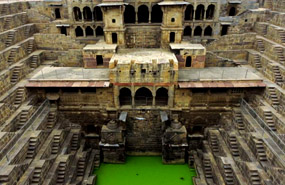
Abhaneri was named as Abha Nagri, which means the city of brightness, but due to mispronunciation of the term, it is changed to the present name.
In the present day, this city of brightness is in ruins; still it attracts tourists from across the globe. Abhaneri is prominent for 'Baoris', which are the unique invention of the natives for harvesting rain water. Amongst the other step wells, Chand Baori is the most popular one. This colossal step well is located in front of the Harshat Mata Temple. Chand Baori is one of India's deepest and largest step wells. The huge tank with delicate carvings is certainly delightful to the eyes.
Step wells are the unique concept of India. These big tanks were used as cool places of resort and water reservoir in parched days. It was a ritual to wash hands and feet before visiting the temple. Adjoining the Chand Baori, there is a temple, dedicated to Harshat Mata. This temple serves as the other tourist attraction of Abhaneri. Raised during the 10th century, the wrecks of the temple still boast of the architectural and sculptural styles of ancient India.
Harshat Mata is considered to be the goddess of joy and happiness. As per the beliefs, the goddess is always cheerful, who imparts her joy and happiness to the whole village. The temple is worth visiting for its amazing architecture and that too, which belongs to the medieval India. Abhaneri has a glorious past and this hoary magnetism of the place, attracts tourists to its threshold, from all over the world.
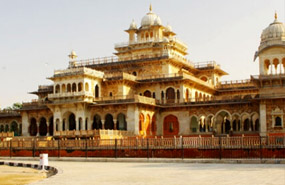
The best of all museums is Albert Hall Museum. This museum provides exclusive collection of artifacts, objects and other art forms. The building of Albert Hall Museum was built in 1876 as a concert hall. The museum gets its name from the Victoria and Albert Museum of London, because of the similarity of architecture. The foundation for the building started in 1876, when Prince of Wales visited Jaipur. When the building was constructed, the royals and government did not have any idea about usage of the building. It was initially used as Town Hall in 1880. Later, the King of Jaipur, Maharaja Sawai Madho Singh II suggested to use it as a museum for Industrial Arts. Later, the hall was used for displaying masterpieces of local artisans.
In 1881, the museum was at its prime beauty and people from across the country visited this museum to buy or enjoy handicrafts, artwork and other masterpieces. However, the building was under construction until 1887. Later, the museum started to showcase artifacts and ancient artworks along with budding artist's masterpieces.
The building holds Indo-Saracenic architecture and exclusive stone ornamentation. The museum was famous for its architectural beauty since its inauguration. The corridors of the museum hold numerous mural paintings, Persian painting and others. The murals on display expresses ancient civilization and reigns like Green, Babylonian, Chinese and others.
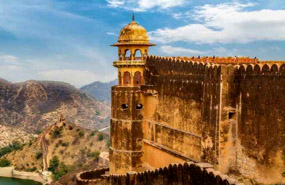
Jaigarh Fort is Located on the Hill of Eagles, Jaigarh fort was built in 1726 AD by Sawan Jai Singh II. Jaigarh Fort is located at a height of 500 feet above sea level and offers panoramic views of the surrounding. It houses the world's largest cannon on the wheels called 'Jaivana Cannon'. There are various other attractions within the fort like Laxmi Vilas, Lalit Mandir, Aram Mandir and the Vilas Mandir.
Jaigarh Fort is made-up of sandstones and is spread over an area of 3 km. Made with the purpose of protecting Amer Fort, Jaigarh fort is considered as the strongest monument of Jaipur. Also known by the name of 'Victory Fort', this place was considered as a storehouse of all the war amours, cannons, arms and ammunitions. There is a Persian style garden within the complex of the fort which is divided into 4 parts. The best part about the fort is its windows which are made of lattices. These windows allow a complete view of the exteriors, but nothing can be observed from the outside.
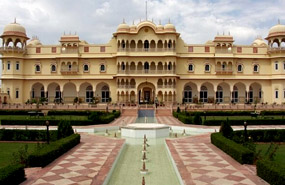
Nahargarh Fort was commissioned in the year 1734 by Maharaja Sawai Jai Singh II, the founder of Jaipur. Placed on the lofty Aravalli Hills, the fort was a retreat palace for the ruler. Nahargarh and Jaigarh fort are connected to each other through their extended ramparts.
There is also a legend connected to the fort. It is believed that the fort was cursed by the spirit of Nahar Signh Bhomia, a Rathore prince. Maharaja Sawai Jai Singh found this property which once belonged to the said prince and the Maharajs thought about raising a fort here. But, the spirit of the prince was not happy with the idea. Nevertheless, the construction started. The part of construction that was done in the morning was found completely destroyed the next day. When Maharaja Sawai Singh came to know of this, he built a small fort inside the premises of the fort and dedicated it to the prince. Later on, a small temple was also built here. The prince's spirit was now happy.
In the year 1868, King Sawai Ram Singh renovated the fort. After this, Maharaja Sawai Madho Singh, in the year 1880, thought of an idea to turn this fort into a luxury retreat. He commissioned Raj Imarat to make the fortress within the fort that would be used as for recreation purpose. This amusement place was named Madhavendra Bhawan. This enchanting structure with wall paintings, fine interiors and stucco patterns was architected by Vidyadhar Bhattacharya, the architect of Jaipur.
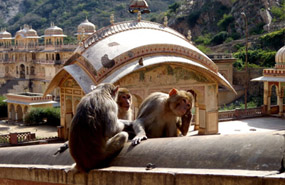
The Temple is Situated at about a distance of 10km from Jaipur in the city of Khania-Balaji, the Galtaji temple is a Hindu pilgrimage often visited by the people from all over the country.
There are many temples in this site and one the special attractions of the place is a natural spring that flows downwards from the hill top. The water from this spring fills up many kunds or water tanks which are considered very sacred and the pilgrims visiting the temple take bathe in this pious water. The temple comprises of 7 holy water tanks or kunds out of which the Galta Kund is the most significant of all. The water of this kind is believed to be different from anywhere else which makes it even more fascinating for the visitors to watch.
The temple is often called as the Monkey Temple as you will find many apes roaming about here within the complex. This famous temple of Jaipur is dedicated to Lord Hanuman who is also called the Sun God. This wonderful holy temple of the Hindus is made of pink sandstone and the temple appears more like a palace than a place of worship. As the temple is located on the Aravalli Hills, it offers a fantastic view of the city of Jaipur from the hilltop. The surrounding of the temple also creates a lovely landscape with green vegetations on all sides. You will also find small temples dedicated to Lord Rama and Lord Krishna being established within the complex. The walls of the temple are beautifully painted and decorated with curved pillars and rounded roofs. This holy shrine experiences a lot of crowd every year during the occasion of Makar Sakranti when a large number of devotees visit the temple to take dip in the holy waters of the kund.
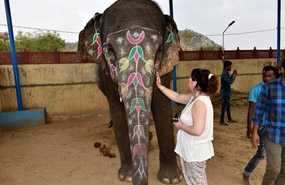
Elephant village in Jaipur is a small community village that was set-up by the local government of Rajasthan in 2010 to provide a proper shelter & water facilities to the families who take care of Elephants along with providing a natural habitat for these giant animals surrounded by the Aravali mountain ranges. If you are an animal lover, this will be the best things to do in Jaipur for you.
Rajasthan being a desert land, is not a natural habitat for Elephant & therefore, Jaipur is the only place in Rajasthan to have Elephants which were brought from the jungles of South India. The most interesting thing about the Elephant village is, the Elephants do not belong to Rajasthan & even the Elephant care takers are not local & instead they belong to an eastern state of India - Bihar.
Elephant village in Jaipur is definitely one of the most interesting places to spend time at. The location of the village which is set-up amidst Aravali Mountains adds to the fun and makes it a bespoke travel opportunity and one of the best things to do in Jaipur that can also be incorporated in your Rajasthan tour packages.
A day with Elephants - with Vedic Walks is a unique and offbeat activity to offer a memorable Elefantastic day to our guests in Jaipur not only by engaging in fun activities with Elephants but also giving it back to the community by spending some time the local community members. It is an Eleday with lots of Elefun.
Even if you do not wish to take an Elephant safari in Jaipur, we recommend you to visit Elephant village in Jaipur and spend quality time praising their beauty. Although, if you missed out Elephat safari at Amer Fort, Elephant village will be an apt place for taking an Elephant safari in the natural surroundings.
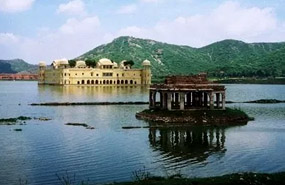
Lake Man Sagar is easily accessible from Jaipur as the western side of the lake is bound by the main road to Amer and the eastern side is close to the 11C, the Jaipiur-Delhi National Highway
Lake Man Sagar (Mansagar) is an artificial lake to the north of Jaipur in which the stunning Jal Mahal Palace stands. Lake Mansagar has undergone an amazing transformation over the last 5 years, where once it was a dirty and polluted sewage overspill for Jaipur today the lake is teeming with life and migratory birds are now returning to the fresh waters.
The lake volume varies dramatically between the wet season to the dry as the only source of water is rainwater from the surrounding hills and the semi-clean effluent flow from Jaipur. The lake was primary constructed for irrigation and today's intensive farming strains the water resources, so much so that in 2008 the lake completely dried up. The lake covers an area of 300 acres and has an average wet season depth of 4 meters.
The Jal Mahal palace at the centre of the lake was originally constructed in the 18th century as a shooting lodge by the Maharaja, as the lake was a thriving home to diverse wildlife that included a large flamingo population. The destructive pollution of the 1990s combined with intensive farming demands significantly reduced the extent of aquatic wildlife and migratory birds found more suitable locations but things are being reversed. Today grey heron, wagtails and blue-tailed bee-eaters are all making a comeback while fish stocks are even increasing.
